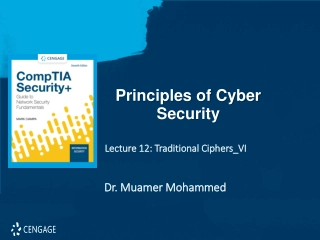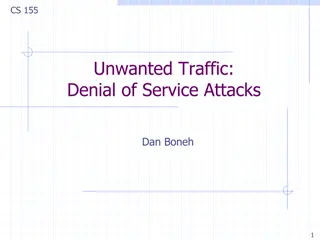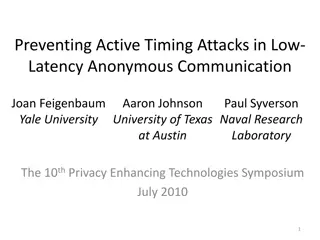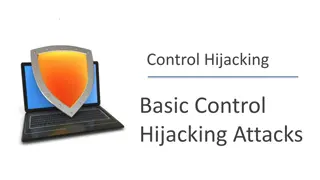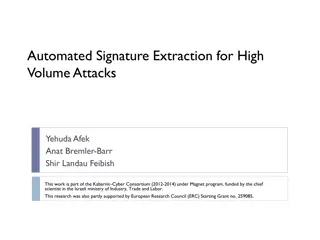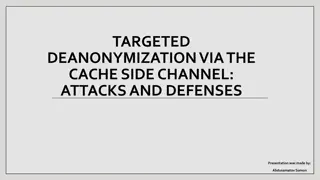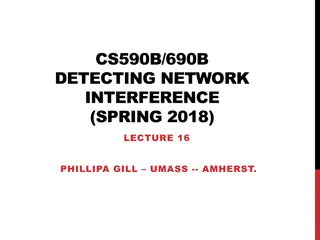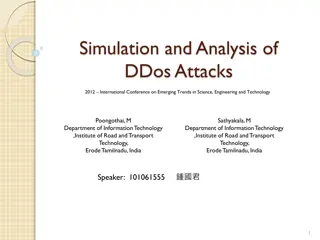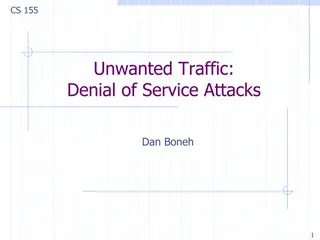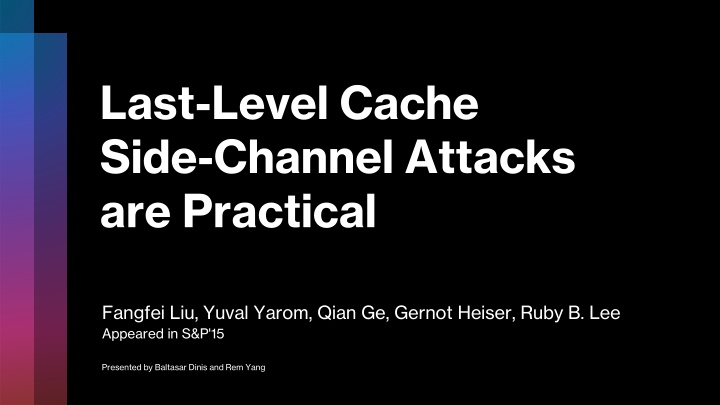
Practical Last-Level Cache Side-Channel Attacks in S&P'15
Discover how last-level cache side-channel attacks work, the challenges involved, and solutions to target specific cache sets. Learn about Prime+Probe attacks and prerequisites for executing them effectively.
Uploaded on | 1 Views
Download Presentation

Please find below an Image/Link to download the presentation.
The content on the website is provided AS IS for your information and personal use only. It may not be sold, licensed, or shared on other websites without obtaining consent from the author. If you encounter any issues during the download, it is possible that the publisher has removed the file from their server.
You are allowed to download the files provided on this website for personal or commercial use, subject to the condition that they are used lawfully. All files are the property of their respective owners.
The content on the website is provided AS IS for your information and personal use only. It may not be sold, licensed, or shared on other websites without obtaining consent from the author.
E N D
Presentation Transcript
Last-Level Cache Side-Channel Attacks are Practical Fangfei Liu, Yuval Yarom, Qian Ge, Gernot Heiser, Ruby B. Lee Appeared in S&P'15 Presented by Baltasar Dinis and Rem Yang
Side-channel attacks are hard to deploy The L1i, L1d (and L2) caches are: Fast and small high timing resolution easier to attack Core-private, thus unlikely to be shared among cloud clients DRAM LLC Cloud providers disable page sharing between VMs o This thwarts both FLUSH+RELOAD and EVICT+RELOAD attacks L1 L1 2
Prime + Probe Attacker Victim Ways Sets 3
Prime + Probe Prime a cache set Attacker Victim Ways Sets 4
Prime + Probe Prime a cache set Attacker Victim Wait for some time Ways Sets 5
Prime + Probe Prime a cache set Attacker Victim Wait for some time Ways Probe cache set Sets 6
Prime + Probe Victim did not access cache set Attacker Victim Attacker probe is fast Ways Sets 7
Prime + Probe Victim did access cache set Attacker Victim Attacker probe is slow Ways Sets Evict 8
Solving the "easy" challenges Q: If the secret data is in the L1, how can we observe data accesses in the LLC? A: Leverage the fact that the LLC is inclusive evicting data in the LLC forces an eviction in the victim L1 DRAM LLC Q: How to target specific cache sets in the LLC if it is physically indexed? L1 L1 A: By using huge pages in the attacker code, all the set index bits are in the page offset (constant under address translation) 9
Prerequisite for PRIME+PROBE Ways DRAM Sets LLC L1 L1 Attacker needs to know which memory accesses map to the same cache set (the eviction set) 10
The LLC is sliced, and that's complicated Each core is connected to a local slice of the LLC, use a ring bus to handle remote accesses o Slice ID is computed from a hash of the address DRAM LLC0 LLC1 The access latency varies with which slice we are targeting we need to PRIME+PROBEwithin the same slice to get consistent time readings L1 L1 11
PRIME+PROBE on the sliced LLC is hard Slice 0 Attacker needs to know which memory accesses map to the same cache set and cache slice Slice 1 Slice 2 12
Constructing the Eviction Set lines Goal: partition lines(in the same set) into per-slice eviction sets For illustration, assume LLC has 2 ways and 2 slices eviction_set_1 eviction_set_0 13
Constructing the Eviction Set lines conflict_group Construct the minimal group of lines that span the entire set across all slices For each candidate in lines: o If not conflicts with conflict_group: Move to conflict_group eviction_set_1 eviction_set_0 14
Constructing the Eviction Set Partition the conflict_group by slice lines conflict_group For each candidate left in lines: o Use it to distinguish members of theconflict_group; if they conflict, they belong to the same slice eviction_set_1 eviction_set_0 15
Attacking Square + Multiply Exponentiation // compute b^e % mod Used in both RSA and ElGamal decryptions // e is secret Repeatedly PRIME+PROBEthe LLC func sq_mul(b, mod, e): r = 1 Observe intervals between cache accesses made by the square operation for i in len(e): r = square(r) % mod // secret dependent Temporal pattern differs due to secret-dependent memory accesses o Corresponds to bits in exponent if e_i == 1: r = r * b % mod return r 16
0 17
00 18
001 19
0011.... 20
The Good, The Bad... The attack is practical, even with: o Non-collocated cores o No knowledge of any page table mappings (victim and attacker) o No page-sharing between victim and attacker In a real system, it is non-trivial to figure out what cache set maps to a particular part of the code Requires information about the software artifact the victim is using No need to reverse the sliced cache hash function Experiments were run in isolation: real cloud will be noisier and harder to figure out Higher bandwidth than prior work (1.2Mb/s vs 190Kb/s) 21
... and The Future (work) Explore how the attack could extend to NUMA architectures o Sounds hard: how to prime remote memory? Automatic detection of secret-dependent accesses o Sample from a lot of known crypto libraries o Train a model o Attach a model to the attacker code, PRIME+PROBE the collocated clients continuously With such an automatic side-channel detection build an automated tool for exploiting collocated clients o Identify web services by measuring latency from inside the datacenter o Extract keys from TLS negotiation o (scare everyone in the process?) 22




